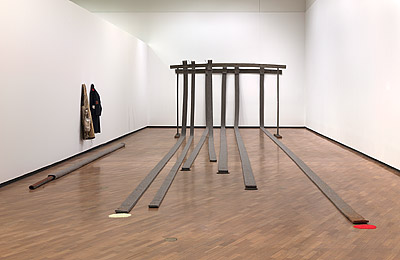Joseph
BEUYS
Germany
1921
–
1986
Stripes from the house of the shaman 1964-72
1980
felt, wood, coats, animal skin, rubber tube, pamphlets, copper, quartz and ground minerals, pigments
not signed, not dated
overall
340.0 (h)
x 655.0 (w)
x 1530.0 (d)
cm
Purchased 1981
National Gallery of Australia, Canberra
NGA 1981.2110.A-K
© Joseph Beuys. Licensed by Bild-Kunst & VISCOPY, Australia
Joseph Beuys, the most influential avant-garde artist of the 1970s and 1980s, was an enigmatic figure who saw himself as a modern shaman, healing a sick society with his performances and ritual objects. The shaman is a mediator between earthly and spiritual worlds, a role not unlike that of an artist. In an almost allegorical tale, Beuys tells how, while a Luftwaffe pilot in 1943, he was pulled from his crashed plane by nomadic Tatars in the snowy wastes of Crimea. ‘They covered my body in fat to help it regenerate warmth, and wrapped it in felt as an insulator to keep in the warmth.’[1]
Stripes from the house of the shaman 1964–72 1980 shows the artist’s central themes of redemption and transformation. The sculpture consists of seven lengths of grey industrial felt which traverse the floor to a crude wooden archway. A small fir branch, like a miniature tree, is mounted on the end of the felt strips. Small heaps of iron phosphate, sulphur and cinnabar punctuate the opposite ends of the strips. Two coats hang on the side wall. On the floor, between the coats and the felt pathways, is a ‘battery’ made from a copper rod wrapped in felt.
The symbolism of the portal that dominates the installation is readily apparent―it is an image of transition, perhaps a doorway to another realm. Passing through the arch symbolises birth or death, not just in shamanistic ceremonies, but in most cultures. Felt is made of animal hair, transformed into fabric. It is a source of warmth and insulation, and ‘absorbs anything with which it comes in contact―fat, dirt, dust, water or sound―and is therefore quickly integrated into its environment’.[2] In the work, the felt paths lead inward and upward, from a horizontal, earthly world to a celestial one. The fir tree represents life, and acts as a capital for the columns of felt. The felt also insulates the copper conductor in the energy-giving ‘battery’. Among its other qualities, copper is used in homoeopathic medicine, and is associated with Venus and femininity. The conjunction of opposites is intrinsic to Beuys’s ‘theory of sculpture’, which contrasted logic and intuition, male and female principles, warm and cool elements, molten and solid, soft and hard, emotional and intellectual, natural and cultural.
Two coats symbolise warmth and insulation, while also representing disguise, or perhaps magic cloaks for the shaman to don. Hanging casually, they suggest readiness to travel, or sudden return. The garments stand for the artist, while simultaneously confirming his absence from the installation. A hare-skin bag containing rock crystal hangs from the seal-skin coat. The hare, which Beuys adopted as a personal totem, is associated with the moon, and is a hero of folk tales. By the early 1970s Beuys felt he had completed his private transformation, and was ready to begin the public revolution. He defined politics as ‘social sculpture’.
Beuys explained: ‘[M]y intention is … to stress the idea of transformation and of substance. That is precisely what the shaman does in order to bring about change and development: his nature is therapeutic.’[3] The objects have the power of a fetish, something that compresses the ordinary into a symbol of compelling potency. In his informally structured sculptures there is a provocative lack of beauty because, Beuys said, ‘it is the transformation of substance that is my concern in art, rather than the traditional aesthetic understanding of beautiful appearances’.[4]
Michael Desmond[5]
Senior Curator
National Portrait Gallery, Canberra
[1]Beuys, quoted in Caroline Tisdall, Joseph Beuys, Solomon R Guggenheim Museum, New York, 1979, p16
[2] Beuys, quoted in Tisdall, p74
[3]Beuys, quoted in Tisdall, p23
[4] Beuys, quoted in Tisdall, p10
[5] From Michael Desmond, ‘Joseph Beuys: Stripes from the house of the shaman 1964–72’, in Kate Davidson and Michael Desmond, Islands: contemporary installations from Australia, Asia, Europe and America, National Gallery of Australia, Canberra, 1996, pp 39–46; edited by Christine Dixon, 2008

